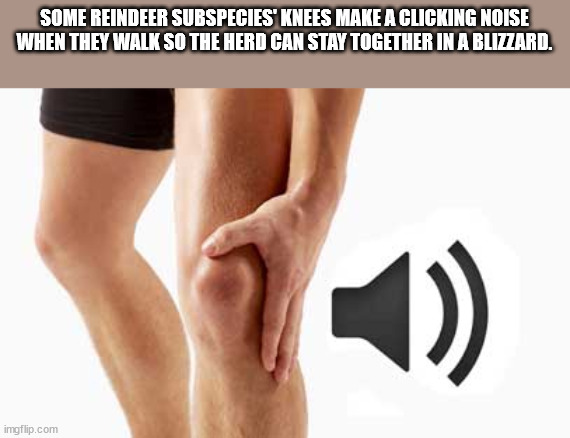Some reindeer have knees that make a clicking sound when they walk it helps them keep together in a blizzard

Some Reindeer have knees that make a clicking sound when they walk. It helps them keep together in a blizzard.

Reindeer, also known as caribou, are fascinating animals with incredible adaptability to survive in harsh Arctic conditions. These magnificent creatures possess unique characteristics that enable them to thrive in extreme cold temperatures and challenging environments. One intriguing fact about reindeer is that some of them have knees that make a clicking sound when they walk. This distinctive feature plays a crucial role in helping them stay together in a blizzard.

The clicking sound produced by their knees serves as a form of communication among reindeer herds, especially during heavy snowstorms and blizzards. The Arctic is known for its treacherous weather conditions, including blinding snowstorms that can disorientate and pose a threat to reindeer herds. In such situations, visual cues become ineffective, and reindeer rely heavily on their acute sense of hearing and the clicking of their knees to maintain cohesion within the group.
During the winter months, when reindeer migrate in search of food or to escape predators, they form large herds that can consist of thousands of individuals. These herds are essential for their survival as they provide protection against predators and help them endure the harsh weather conditions. However, navigating through snow-covered landscapes can prove challenging, especially during blizzards when visibility is severely reduced.
To overcome this obstacle, reindeer developed a remarkable adaptation that allows them to keep track of each other even in the most adverse weather conditions. When a reindeer takes a step forward, tendons snap over a small bone in their knee joint, producing a distinct clicking sound. The clicking sound is amplified due to the structure of the leg bones, which acts as a natural resonating chamber.
This clicking mechanism allows reindeer to maintain a constant sense of each other’s presence within the herd, even when they cannot see one another. By listening to the clicking sounds, they can perceive the distance, direction, and speed of other individuals within their vicinity. This ability allows reindeer to adjust their movements accordingly, ensuring they stay close together and do not get separated, which is crucial for their collective survival.
Moreover, the clicking sound serves as a signal for straying individuals to find their way back to the herd during a blizzard. If an individual reindeer gets separated from the group due to reduced visibility, it can locate the herd by following the clicking sounds produced by their companions. This auditory homing mechanism is a remarkable adaptation that enhances the chances of survival for reindeer in the harsh Arctic environment.
In conclusion, some reindeer possess knees that produce a clicking sound when they walk. This unique feature serves as a crucial communication mechanism within the herd, especially during blizzards when visual cues may be ineffective. The clicking sound helps reindeer maintain cohesion, navigate through thick snow, and find their way back to the herd if separated. It is yet another remarkable adaptation that allows reindeer to thrive in the challenging Arctic conditions they call home.
Source: Animal Facts Encyclopedia - Link
Tags
Share
Related Posts
Quick Links
Legal Stuff

